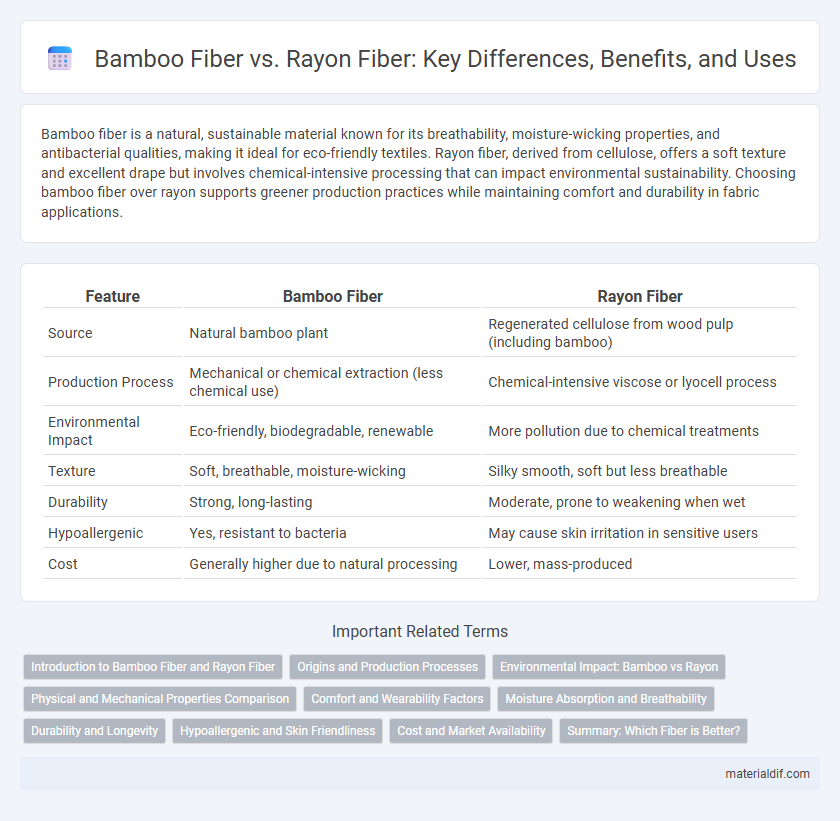Bamboo fiber is a natural, sustainable material known for its breathability, moisture-wicking properties, and antibacterial qualities, making it ideal for eco-friendly textiles. Rayon fiber, derived from cellulose, offers a soft texture and excellent drape but involves chemical-intensive processing that can impact environmental sustainability. Choosing bamboo fiber over rayon supports greener production practices while maintaining comfort and durability in fabric applications.
Table of Comparison
| Feature | Bamboo Fiber | Rayon Fiber |
|---|---|---|
| Source | Natural bamboo plant | Regenerated cellulose from wood pulp (including bamboo) |
| Production Process | Mechanical or chemical extraction (less chemical use) | Chemical-intensive viscose or lyocell process |
| Environmental Impact | Eco-friendly, biodegradable, renewable | More pollution due to chemical treatments |
| Texture | Soft, breathable, moisture-wicking | Silky smooth, soft but less breathable |
| Durability | Strong, long-lasting | Moderate, prone to weakening when wet |
| Hypoallergenic | Yes, resistant to bacteria | May cause skin irritation in sensitive users |
| Cost | Generally higher due to natural processing | Lower, mass-produced |
Introduction to Bamboo Fiber and Rayon Fiber
Bamboo fiber is a natural textile made from the pulp of bamboo grass, known for its softness, breathability, and eco-friendly properties due to sustainable cultivation and biodegradability. Rayon fiber, a semi-synthetic material derived from cellulose, often wood pulp or bamboo, undergoes chemical processing to produce a versatile fabric with a silky texture and excellent moisture absorption. Both fibers are popular in the textile industry, with bamboo fiber emphasizing sustainability and rayon fiber valued for its smooth feel and adaptability.
Origins and Production Processes
Bamboo fiber originates from the natural cellulose found in bamboo plants, which undergoes mechanical or enzymatic processes to extract the fibers, maintaining its eco-friendly attributes. Rayon fiber, although derived from cellulose as well, involves chemical-heavy production methods where wood pulp or bamboo is dissolved and regenerated, leading to less sustainable environmental impacts. The key difference lies in bamboo fiber's more natural extraction process compared to rayon's intensive chemical regeneration.
Environmental Impact: Bamboo vs Rayon
Bamboo fiber is considered environmentally friendly due to its rapid growth and minimal pesticide use, making it a sustainable alternative to traditional textiles. Rayon fiber, derived from wood pulp, involves intensive chemical processing that can lead to deforestation and pollution if not managed responsibly. Bamboo fiber production generally has a lower ecological footprint compared to conventional rayon manufacturing, highlighting its advantage in eco-conscious textile choices.
Physical and Mechanical Properties Comparison
Bamboo fiber demonstrates superior tensile strength and higher elasticity compared to rayon fiber, making it more durable under mechanical stress. Bamboo fibers exhibit better moisture absorption and breathability, which enhance comfort and reduce bacterial growth. Rayon, derived from chemically processed cellulose, tends to have lower abrasion resistance and weaker structural integrity than naturally strong bamboo fibers.
Comfort and Wearability Factors
Bamboo fiber offers superior breathability and moisture-wicking properties compared to rayon fiber, enhancing overall comfort during wear. Its natural antibacterial qualities reduce odor, making bamboo fabric more suitable for prolonged use. Rayon fiber, while soft, lacks the same durability and moisture management, often resulting in less comfortable wear over time.
Moisture Absorption and Breathability
Bamboo fiber exhibits superior moisture absorption and breathability compared to rayon fiber, making it ideal for activewear and breathable fabrics. Bamboo fibers naturally wick moisture away from the skin while allowing air circulation, enhancing comfort and reducing sweat accumulation. Rayon fiber, derived from cellulose but chemically processed, tends to retain more moisture and offers less ventilation, resulting in lower breathability than bamboo fiber.
Durability and Longevity
Bamboo fiber offers superior durability and longevity compared to rayon fiber due to its natural cellulose structure and antimicrobial properties, which resist wear and tear over time. Rayon fiber, being a regenerated cellulose fiber, tends to weaken faster after repeated washing and exposure to moisture, causing it to lose strength and shape. Bamboo fiber fabrics maintain their integrity and softness longer, making them a more sustainable and long-lasting textile choice.
Hypoallergenic and Skin Friendliness
Bamboo fiber is naturally hypoallergenic and gentle on sensitive skin due to its antimicrobial properties and smooth texture, reducing the risk of irritation and allergic reactions. Rayon fiber, although derived from natural cellulose, undergoes extensive chemical processing that can leave residues potentially irritating to skin. Consumers with sensitive skin or allergies often prefer bamboo fiber for its safer, more skin-friendly profile.
Cost and Market Availability
Bamboo fiber generally costs more than rayon fiber due to its eco-friendly processing and sustainable sourcing methods. Rayon fiber, derived from wood pulp and chemically treated, is more widely available and often preferred in mass-market textiles because of its lower price and consistent supply. Market availability favors rayon fiber, while bamboo fiber appeals to niche markets emphasizing environmental benefits despite higher costs.
Summary: Which Fiber is Better?
Bamboo fiber offers superior sustainability, natural antibacterial properties, and enhanced breathability compared to rayon fiber, which is chemically processed and less environmentally friendly. Rayon fiber provides a smooth texture and affordability but lacks the eco-friendly advantages and durability of bamboo fiber. Choosing bamboo fiber supports a greener lifestyle with added comfort and health benefits.
Bamboo Fiber vs Rayon Fiber Infographic

 materialdif.com
materialdif.com